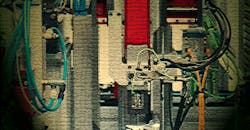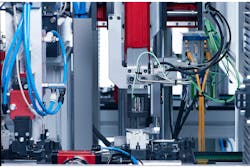Achieving 100% Quality Assurance with Miniature Force-Sensor Systems
Download this article in PDF format.
While technology across multiple industries continues to trend smaller and smaller, which means miniaturization of all types of devices and their components, demands placed on them for more functionality are at a fever pitch. This has been particularly noticeable in the electronics sector, where manufacturers design ever-smaller technical devices and control elements. This, in turn, creates significant challenges when it comes to production, because manufacturers must guarantee that all of the components produced have the same quality. At the same time, the production area must also continuously adapt to accommodate new issues arising from these changes.
Smartphones are our daily companions. They offer high functionality while occupying very small spaces, thanks to compact and minimalistic designs. The same holds true for vehicle dashboards—they feature an increasing number of displays and control elements with a wide variety of functions in a much smaller footprint. Both are subject to the same requirements, though—to achieve satisfying and successful operation of the device, functionality and haptics need to work together in perfect synergy.
The space-saving, compact design of force sensors makes it possible to measure the smallest forces.
Everything at the Push of a Button (Functionality)
The central element of a typical smartphone is the “Home” button, which users employ to navigate through menus in a targeted and reliable way. At the same time, the home button must also be capable of executing multiple functions: one click can close the application, while a double-click opens a new menu, and a "press and hold" opens a different function.
Similarly, the control switch of a vehicle’s electronic parking brake must be reliable when activated so that the car doesn’t roll away when it’s parked or on a slope. The driver must be able to fully rely on it at all times. At the very least, a malfunctioning parking brake can lead to a loss in trust from the driver and potentially put their lives, as well as those of their passengers and other road users, at risk.
In both of the above cases, the malfunctioning of one small switch can easily result in economically damaging consequences for the manufacturer.
It’s a Matter of Feel (Haptics)
When it comes to a satisfactory user experience, the haptics related to the activation of a device can be just as important as its functionality. The feeling of a product during use must meet the consumer’s expectations. It’s not enough, therefore, for the smartphone’s home button to simply operate properly—it must also signal to the user that it was successfully activated. That feeling comes as the result of haptic feedback (whether a tactile, audible, or visible response). This feedback, therefore, acts as a means of ensuring the user is made aware that the functionality has been engaged.
A uniform operating concept gives the driver a safe driving experience and a high degree of satisfaction. Despite the fact that a vehicle may contain components from multiple, diverse suppliers, the driver still expects that all switches and mechanisms will operate uniformly and the effort needed to activate them meets his/her expectations. In fact, varying levels of effort can even help the driver identify the switch being activated. For example, it usually requires greater physical effort to operate the parking brake of a vehicle or turn on the hazard lights than it does to activate the electric window or windshield wiper control.
100% Tested, 100% Precision
Anybody who activates a switch expects that the desired effect will follow. Therefore, haptic and functionality testing must guarantee 100% quality assurance. Only a thorough check of each individual switch by the manufacturer can ensure that any substandard or faulty parts are rejected at an early stage. During the quality test, a sensor measures the effort needed to activate a switch and a good/bad assessment is made based on the measured path-force plot. Identified “bad” parts can then be rejected immediately. This not only provides 100% quality assurance, but it also reduces production costs because unsuitable parts are not mistakenly installed.
Both haptics and functionality must be tested to guarantee 100% quality.
To ensure precise measurement and exclude measuring inaccuracies (for example, those caused by bending moments), the force application area at the sensor—and therefore the sensor itself—should be as small as possible. The size of the sensor also plays an important role in test automation, because oftentimes only a small space is available to install the sensor for these applications.
So, how is it possible to measure even the smallest forces with a high accuracy rate?
Measurements from Tiny Spaces
The miniaturization trend not only reduces the space available for the components, but also the space for the measuring sensors. Miniaturization has the following core requirements:
- Compact design: To keep up with the trend toward components using ever-smaller switches, the sensors must be small enough to test buttons that are being installed very close to each other.
- High accuracy: High measurement and repeatable accuracy are important for ensuring product quality as well as a pleasant user experience.
- High overload: Sensors that can’t resist a higher load when a component is incorrectly inserted may be damaged and must be replaced.
- Wide measuring range: Small operating forces for products used daily are normally measured in a range between 0.1 N and 500 N.
One Step Ahead
As we’ve discussed, small spaces and high accuracy place heavy demands on sensor systems. However, advance such as miniature piezoelectric force-sensor technologies make it possible to meet these requirements.
These tiny instruments are able to take very precise measurements with the smallest force application areas, while producing excellent repeatability and high resolution even when testing switches and keys. At the same time, the sensors are also very robust, overload-safe, and more durable than other sensor technologies. The smallest force sensor available worldwide has a maximum diameter of 6.1 mm, an overall height of just 23.3 mm, and yet is capable of measuring forces of –20 N up to 200 N.
The Type 9217A force sensors developed by Kistler can measure the tiniest of forces.
Piezoelectric sensors provide a superior price/performance ratio compared to sensors with strain gauges (DMS). The latter must be integrated into the production line using adapters, while piezoelectric force sensors can be installed on a mounting plate directly through an external thread. Thus, the design of complicated, and therefore expensive, recording elements isn’t required. In addition, this type of mounting makes it possible to arrange several sensors in tight spaces, which enables, for example, the testing of a closely arranged row of keys in sequence.
The future is getting smaller. However, thanks to a new generation of highly developed electronic “helpers,” manufacturers are in a position to establish new standards even for the smallest applications.
About the Author
Stefan Schäfer
Product Manager for Production Monitoring Business Unit
Stefan Schäfer is product manager for the Production Monitoring business unit at Kistler Instrumente AG in Winterthur, Switzerland. Mr. Schäfer is very experienced in the area of piezoelectric force measurements and their applications. The product family of the piezoelectric force sensors for smallest forces is destined for industrial environments, where 100% quality assurance represents a success factor.




